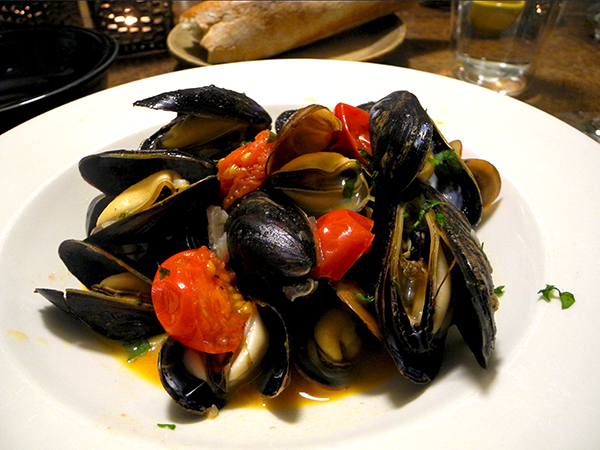looks like a flattened bouquet
Yes, it definitely looks like I had a lot of greenery on hand, but I think I managed to disguise some of its volumes with a little judicious mixing with other elements of the meal.
And this wasn’t just ordinary greenery, as it included upland cress, wild garlic (bulb and green), stone crop, lovage, fresh oregano (ordinary, except that it’s a survivor from last fall), and borage flowers!
- two crab cakes from PE & DD Seafood (ingredients: crab, egg, flour, red & green peppers, garlic, salt, pepper, breadcrumbs, mayonnaise, milk, celery, parsley), heated in a small heavy cast iron pan, 3 to 4 minutes on each side, and served on a salsa composed of 6 Backyard Farms Maine ‘cocktail tomatoes’ from Whole Foods, which had been chopped and combined with salt, freshly-ground black pepper, a bit of homemade French Basque piment d’Espellate purchased in a small town north of Baie-Comeau, Quebec last year from the producer’s daughter, some crushed dried pepperoncini, and some chopped fresh oregano leaves from Stoke’s Farm (which I have been husbanding for months in the refrigerator!), the salsa covering much of a bed of undressed stone crop (a succulent, aka orpine, aka sedum) from Lani’s Farm, the dish finished with a few drops of olive oil, some of the liquid remaining from the salsa, and some gorgeous blue borage flowers from Two Guys from Woodbridge
- five red Norland potatoes from John D. Madura Farm (these potatoes have grown especially sweet over the winter), scrubbed, boiled in salted water unpeeled, halved, tossed with olive oil and chopped tiny wild garlic bulbs and stems from Lani’s Farm, sprinkled with chopped lovage from Two Guys from Woodbridge, and mixed, still in the pan in which they were boiled, with cultivated upland cress from Alewife Farm
There was a cheese course included 3 cheeses and thin toasts of potato bread.
- the cheeses were Consider Bardwell’s ‘Experience’, a pasteurized cow cheese still in the developing stage; their ‘Manchester’ goat cheese; and an adaged goat cheese from Vermont Creamery, ‘Coupole‘
- with the cheese there were very thin slices of potato bread (Balthazar’s ‘Potato Fendu’) from Whole Foods, toasted
- wine throughout was a South African (Swartland) white, Badenhorst Secateurs Chenin Blanc 2013, from Flatiron Wines & Spirits
- the music with the first course was Q2 streaming, ‘O Haupt voll Blut und Wunden’ by Robert Phillips, ‘Indigena’ by Tania Leon, and Violin Concerto No. 1, “Omnipresence” by Huang Ruo
- the music with the cheese, also via Q2, was gamelan work by Jody Diamond










